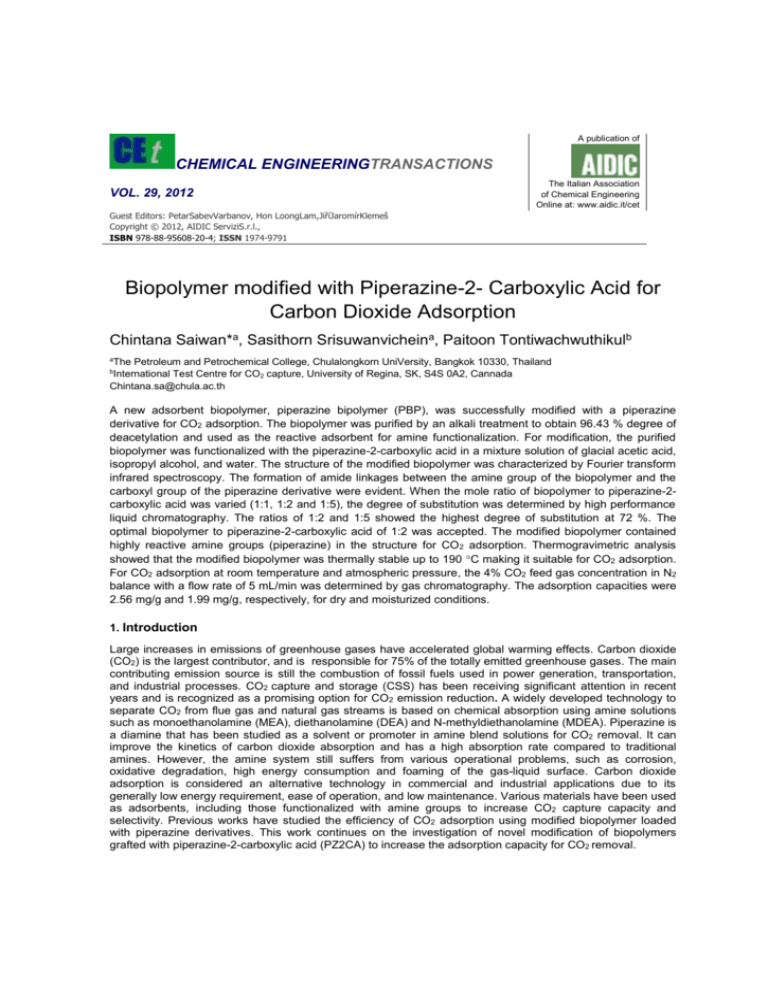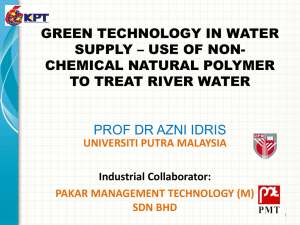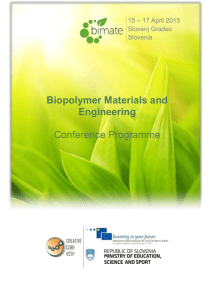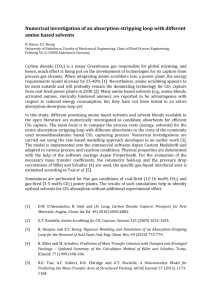Biopolymer modified with Piperazine-2
advertisement

A publication of CHEMICAL ENGINEERINGTRANSACTIONS VOL. 29, 2012 The Italian Association of Chemical Engineering Online at: www.aidic.it/cet Guest Editors: PetarSabevVarbanov, Hon LoongLam,JiříJaromírKlemeš Copyright © 2012, AIDIC ServiziS.r.l., ISBN 978-88-95608-20-4; ISSN 1974-9791 Biopolymer modified with Piperazine-2- Carboxylic Acid for Carbon Dioxide Adsorption Chintana Saiwan*a, Sasithorn Srisuwanvicheina, Paitoon Tontiwachwuthikulb a The Petroleum and Petrochemical College, Chulalongkorn UniVersity, Bangkok 10330, Thailand International Test Centre for CO2 capture, University of Regina, SK, S4S 0A2, Cannada Chintana.sa@chula.ac.th b A new adsorbent biopolymer, piperazine bipolymer (PBP), was successfully modified with a piperazine derivative for CO2 adsorption. The biopolymer was purified by an alkali treatment to obtain 96.43 % degree of deacetylation and used as the reactive adsorbent for amine functionalization. For modification, the purified biopolymer was functionalized with the piperazine-2-carboxylic acid in a mixture solution of glacial acetic acid, isopropyl alcohol, and water. The structure of the modified biopolymer was characterized by Fourier transform infrared spectroscopy. The formation of amide linkages between the amine group of the biopolymer and the carboxyl group of the piperazine derivative were evident. When the mole ratio of biopolymer to piperazine-2carboxylic acid was varied (1:1, 1:2 and 1:5), the degree of substitution was determined by high performance liquid chromatography. The ratios of 1:2 and 1:5 showed the highest degree of substitution at 72 %. The optimal biopolymer to piperazine-2-carboxylic acid of 1:2 was accepted. The modified biopolymer contained highly reactive amine groups (piperazine) in the structure for CO 2 adsorption. Thermogravimetric analysis showed that the modified biopolymer was thermally stable up to 190 C making it suitable for CO2 adsorption. For CO2 adsorption at room temperature and atmospheric pressure, the 4% CO2 feed gas concentration in N2 balance with a flow rate of 5 mL/min was determined by gas chromatography. The adsorption capacities were 2.56 mg/g and 1.99 mg/g, respectively, for dry and moisturized conditions. 1. Introduction Large increases in emissions of greenhouse gases have accelerated global warming effects. Carbon dioxide (CO2) is the largest contributor, and is responsible for 75% of the totally emitted greenhouse gases. The main contributing emission source is still the combustion of fossil fuels used in power generation, transportation, and industrial processes. CO2 capture and storage (CSS) has been receiving significant attention in recent years and is recognized as a promising option for CO2 emission reduction. A widely developed technology to separate CO2 from flue gas and natural gas streams is based on chemical absorption using amine solutions such as monoethanolamine (MEA), diethanolamine (DEA) and N-methyldiethanolamine (MDEA). Piperazine is a diamine that has been studied as a solvent or promoter in amine blend solutions for CO2 removal. It can improve the kinetics of carbon dioxide absorption and has a high absorption rate compared to traditional amines. However, the amine system still suffers from various operational problems, such as corrosion, oxidative degradation, high energy consumption and foaming of the gas-liquid surface. Carbon dioxide adsorption is considered an alternative technology in commercial and industrial applications due to its generally low energy requirement, ease of operation, and low maintenance. Various materials have been used as adsorbents, including those functionalized with amine groups to increase CO2 capture capacity and selectivity. Previous works have studied the efficiency of CO2 adsorption using modified biopolymer loaded with piperazine derivatives. This work continues on the investigation of novel modification of biopolymers grafted with piperazine-2-carboxylic acid (PZ2CA) to increase the adsorption capacity for CO2 removal. 2. Methodology 2.1 Purification of biopolymer (BP) A biopolymer (100 g) was treated with sodium borohydride (0.5 g) in 2 liters of 50 % (w/w) sodium hydroxide (NaOH) solution in an autoclave for 1 h at 393 K. The purified biopolymer (BP) was filtered and washed with deionized water until a neutral pH was reached. The BP was then dried at 80 ºC overnight in a vacuum oven and later kept in a desiccator until use. 2.2 Characterization of purified biopolymer The functional group in BP was characterized with Fourier transform infrared spectrophotometer (FTIR; Nicolet/Nexus 670) and the degree of deacetylation (%DD) was calculated using equations by Miya et al. (1980). To confirm %DD, the BP was evaluated by the acid–base titration method. The BP (0.05 g) was dissolved in 20 mL of 0.01 N hydrochloric (HCl) solution. The mixture was titrated using the pH- metric technique by adding a standardized solution of 0.1000 N NaOH solution and the solution pH was measured. The %DD was calculated following the equations of Avadi et al. (2004). 2.3 Preparation of piperazine biopolymer (PBP) A BP was modified by amine functionalization with PZ-2-CA in a solution of glacial acetic acid, isopropyl alcohol and deionized water at a ratio of 5:10:2. The purified biopolymer powder (72.25 mmol per sugar unit) was dissolved in 1% w/v glacial acetic acid solution (26 mL) followed by the addition of isopropyl alcohol (52 mL). Piperazine-2-carboxylic acid dihydrochloride (72.25 mmol) was dissolved in deionized water (10 mL). The piperazine-2-carboxlic acid solution was gradually added to the biopolymer solution, which was being kept in iced water, and stirred for 30 minutes, and then stirred for 1 hour at room temperature before being kept at 4 C for 5 days to obtain brown precipitate. The precipitate was filtered and washed with the solvent mixture of isopropyl alcohol and deionized water (5:1, v/v) to obtain the piperazine biopolymer (PBP),1A. Similarly, the modified biopolymer was prepared by varying the mole ratio of BP to PZ2CA (1:2 for 2A and 1:5 for 3A) to find the most PZ2CA addition in the modified biopolymer for use as an adsorbent for CO2 adsorption. Finally, PBP was dried in an atmospheric oven at 373 K for 24 hours and used for this CO2 adsorption study. For moisturized PBP, it was prepared by placing the dry PBP in a chamber, which was saturated with vapor water at room temperature by equilibrating for 20 h. 2.4 Characterization of modified biopolymer The PBP samples were characterized by FTIR for determination of the functional groups. For degree of substitution (%DS) in PBP, the unreacted PZ2CA in the reaction solution before filtering with solvent mixture of isopropyl alcohol and deionized water was measured by high-performance liquid chromatography (HPLC). The Deionized water, acetonitrile and 250mM potassium dihydrogen phosphate (KH 2PO4) at pH 2.3 were used as a mobile phase at a ratio of 50:30:20. The flow rate of the mobile phase was constant at 0.5 mL/min. The reacted PZ2CA was used to calculate %DS using the following equation. Degree of substitution (%DS) = reacted piperazine-2-carboxylic acid (mole) x100 initial purified biopolymer (mole) x %DD 2.5 CO2 Adsorption Premixed 15 % CO2/N2 and pure N2 from separate gas cylinders are controlled by mass flow controllers and mixed in the mixing chamber to obtain 4 % CO2 as illustrated in Figure 1. The mixed gas is then controlled at a fixed pressure for ventilation to enable small quantities of 4% CO2 gas to pass through the rotameter at a flow rate of 3 mL/min, which is regulated by the bubble flow meter. The adsorption column is a vertically oriented tubular glass flow adsorber (4mm id x 6mm od x 39 cm length) for the even distribution of the adsorbent. The column is wrapped with a 40 cm long insulator to maintain constant room temperature (25 ºC). The adsorbent is packed in the top 18.5 cm of the column and capped with glass wool at the top and the bottom to support the adsorbent with the feed was running against gravity. For gas chromatography and thermal conductivity detector (GC-TCD) operation, Rt®-Q-BOND column (0.53 mm id x 20 µm film thickness x 30m length) was used to operate at an isothermal temperature of 40 ºC. The GC injection port was heated to 100 ºC with a spilt flow of 8 mL/min and helium as a carrier gas. For a typical CO2 adsorption, the adsorbent (0.25 g) in the column was pre-dried at 60 ºC for 1 h while purging with N2 gas at 113 mL/min. Then, 4 % premixed CO2 of dry gas was allowed to flow at 3 mL/min into the packed bed adsorber to carry out the experiment at room temperature and atmospheric pressure until the CO 2 concentrations of the feed gas at the outlet of the adsorber reached equilibrium. A WiniLab III V4.6 computer program was used to continuously monitor the downstream CO2 concentration. Eq(1) was used to calculated the dynamic adsorption capacity of the adsorbent (Qads). Qads = FCin t st M (1) Where F (mol/min) is the total molar flow of feed gas, C in is the CO2 concentration of the inlet stream, M is the mass of the solid adsorbent loaded in the column, and t st (min) is the stoichiometric time which was determined from the breakthrough curve according to Eq(2) via MATLAB software. t C t st = (1- ou )dt 0 Cin (2) Where Cin and Cou are the CO2 concentrations of inflow and outflow gas stream of the column, respectively. Figure 1: Schematic flow diagram for CO2 adsorption (Kangwanwatana, 2013) 3. Results and Discussion 3.1 Purification and characterization of purified biopolymer The BP was purified through the hydrolysis reaction to increase the amine group in the structure. Peak intensity of characteristic FTIR spectra of BP at 1655 cm-1 decreased, which presented amide band I (C=O) of the remaining N-acetyl glucosamine units in its structure. The degree of deacetylation (%DD) was determined by using absorbance ratio of the amide (-CONH) band at 1655 cm-1 to that of the 2867 cm-1 band corresponding to C-H stretching. The %DD of BP was found to be 96.80 %. The pH-metric titration method was also used to confirm %DD of 96.05 %, as shown in Figure 2. The average %DD was 96.43 %. Figure 2: Titration curve of purified biopolymer 3.2 Modification and characterization of PBP The PBP product, synthesized by the chemical reaction between the amine groups of the glucosamine units in BP and the carboxylic group of piperazine-2-carboxylic acid (Figure 3) is indicated by the formation of amide linkage as confirmed by the IR spectra in Figure 4. The PBP spectrum shows an increase of the peak intensities of amide I of C-O stretching (1655 cm-1) and amide II of N-H stretching (1598 cm-1). There are wavenumber peaks shifts of amide I (C-O stretching) to 1631 cm-1 and amide II (N-H stretching) to 1520 cm-1 as compared to those of the BP spectrum. Disappearance of the carbonyl group (C=O) of the carboxylic group in the PZ2CA is also observed in PBP, which clearly indicates PZ2CA substitution took place. When the ratio of PZ2AC to biopolymer is varied, the degree of PZ substitution (1A, 2A and 3A) increases to 72% as summarized in Table 1. Therefore, the suitable mole ratio of biopolymer to PZ2CA of 1:2 was used for the modification of biopolymer. Figure 3. Synthesis of PBP % Transmittance 100 95 90 85 80 75 70 65 60 amide II (N-H stretching) 3400 100 95 90 85 80 75 70 65 60 % Transmittance (A) amide I (C-O stretching) 2400 1400 wavenumber (cm-1) 400 (B) amide I amide II (C-O stretching) (N-H stretching) 3400 2400 1400 wavenumber (cm-1) Figure 4: IR spectra of (A) BP and (B) PBP 400 Table 1: Degree of substitution of piperazine-2-carboxylic acid in biopolymer Piperazine Mole ratio biopolymer (PBP) %DS BP:PZ2CA 1A 2A 3A 1:1 1:2 1:3 39.80 72.16 71.08 3.3 CO2 Adsorption Study The dry adsorbent breakthrough curve showed saturation around 6 minutes while the moisturized adsorbent was around 5 minutes (Figure 5). The preliminary adsorption capacities of the dry and moisturized PBP were 0.0581 mmol/g and 0.0453 mmol/g. The adsorption efficiency decreased around 20 % in the presence of moisture at room temperature. 1 0.8 C/C0 0.6 Dry.PBP at 25C 0.4 Moist.PBP at 25C 0.2 0 0 5 10 Time(min) 15 20 25 Figure 5: Breakthrough curve of dry and moisturized PBP at 25 °C and atmospheric pressure. 4. Conclusion The present work demonstrated the new adsorbent for CO2 adsorption by amine functionalization of biopolymer with piperazine-2-carboxylic acid in homogeneous system. The degree of substitution was 72.16 % when the ratio of biopolymer and piperazine-2-caboxylic acid is the ratio of 1:2 for modification of biopolymer. The carbon dioxide adsorption capacity reached 0.0581 mmol/g for dry PBP and the mosturizing effect decreased the adsorption capacity of PBP to 0.0453 mmol/g. Acknowledgement The authors are grateful for the research support of this work provided by the Petroleum and Petrochemical College, the National Center of Excellence for Petroleum, Petrochemicals and Advanced Materials, Chulalongkorn univerity, Thailand. References Avadi, M.R., Sadeghi, A.M., Tahzibi, A., Bayati, Kh.,Pouladzadeh, M., Zohuriaan-Mehr, M.J. RafieeTehrani, M., 2004, Diethylmethyl chitosan as an antimicrobial agent, Synthesis, characterization and antibacterial effects, European Polymer Journal, 40, 1355–1361. Kangwanwatana, W ., 2013, Study of CO2 adsorption using adsorbent modified with piperazine. Master’s thesis, Chulalongkorn University, Thailand. Miya, M., Iwamoto, R., Yoshikawa, S., Mima, S. 1980, I.r. spectroscopic determination of CONH content in highly deacylated chitosan, International Journal of Biological Macromolecules, 2, 323-324.








